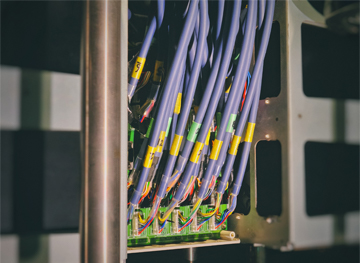A fiber optic transceiver is an integrated circuit (IC) that can independently transmit and receive data in both directions. The device combines a transmitter and receiver into a single module that converts electrical signals into optical signals, enabling these signals to be efficiently transmitted from server to server over fiber optic cables.
The transmitter converts electrical input into optical output from a laser diode or LED light source (light is coupled into an optical fiber through a connector and transmitted through a fiber optic cable). The light from the end of the fiber is coupled to a receiver, and a detector converts the light into an electrical signal, which is conditioned for use by the receiving device.
What is inside a fiber optic transceiver?
Fiber optic transceivers consist of transmitters, receivers, optical devices and chips. The chip is usually regarded as the heart of the fiber optic module. In recent years, there has been growing interest in using silicon photonics in transceiver chips -- building lasers on silicon and then fusing optical components with silicon integrated circuits. It addresses the need for faster connections from rack to rack and across data centers. It effectively simplifies the assembly process. In addition, transceivers can be made more compact, thereby reducing the overall server footprint, enabling smaller, leaner data centers while maintaining high port densities. On the other hand, smaller size means less power consumption and lower cost.
A brief history of fiber optic transceivers
The adoption of silicon photonics technology in transceiver chips is partly a testament to the tremendous progress in fiber-optic transceiver technology. The trend is that fiber optic transceivers are moving towards more compact sizes and higher data rates to accommodate the surge in data traffic brought about by the Internet revolution. The graphic below is a good illustration of how fiber optic transceivers have evolved over the years.
Data Rate Module Last Revision Year Description Application 1 GbpsGBIC2000Gigabit Interface ConverterGigabit Ethernet, SDH/SONET (2.5 Gb/s) and Fibre Channel (4Gb/s)SFP2001 Small Form-Factor Pluggable Gigabit Ethernet, SDH /SONET (2.5 Gb/s) and Fibre Channel (4Gb/s) 10 Gbps XENPAK 2001 Fiber Optic Transceivers for 10Gb Ethernet Typical Router Line Card Applications, Storage, IP Networks and Local Area Networks X2 2005 Fiber Optic for 10Gb Ethernet TransceiversData Centers, Enterprise Wiring Closets, and Service Provider Transport NetworksXFP2005Optical Transceivers for 10Gb Ethernet Supports Fibre Channel (8Gb/s), 10Gb/s Ethernet and Optical Transport NetworksSFP+Enhanced 2013 Small Form Factor Pluggable Supports Fibre Channel (8Gb/s), 10 Gb/s Ethernet and Optical Transport Network Standards OTU240/100 GbpsCFP 2013C Form Factor Pluggable (100G) Supports 40G and 100G 256, OTU3 and OTU4QSFP+/QSFP282013 Quad Small Form-Factor Pluggable 10G and 28G Supports Ethernet, Fibre Channel, InfiniBand and SONET/S up to 40Gb/s and 100Gb/s.




